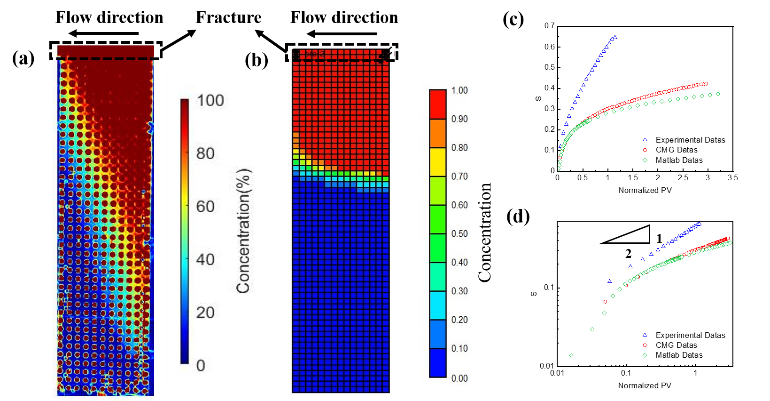Speaker
Description
Miscible displacement in fractured media is ubiquitous in many scenarios such as CO_2 sequestration, shale gas recovery, and reactive transport in groundwater, etc. In dilute solution cases, coupling Fick’s law and Darcy’s law works well in predicting the displacement behavior, which has been incorporated into commercial simulation software such as CMG, UTCHEM and Eclipse. However, non-dilute miscible displacement, which is the more common scenario for subsurface CO_2 sequestration and shale gas recovery, has been rarely investigated. Whether the Fick-Darcy coupling still works remains untested.
In this study, we experimentally investigate miscible displacement in a 3D-printed micromodel that mimics a near-fracture porous medium. The micromodel is first saturated with liquid paraffin (200 cp), and tetradecane (2 cp) is injected into the fracture. Liquid paraffin in the near-fracture porous media is thus displaced by and mixed with tetradecane. Peclect number ($Pe$) in our experiments ranges from $O(1)$ to $O(10^5)$, and the sweep efficiency ($S$) is recorded to characterize displacement kinetics.
The displacement kinetics in low $Pe$ experiments are well predicted by reservoir simulator adopting Fick-Darcy coupling. However, the prediction is less and less accurate with increasing $Pe$. When $\text{Pe} \sim O(10^5)$, the Fick-Darcy coupling completely fails to characterize the displacement, with an anti-intuitive wedge-like displacement pattern (Fig. 1(a)) observed. We identify strong convection deep in the matrix and far from the fracture when displacement front sweeps over, which cannot be rationalized by the Fick-Darcy coupling. The evolution of $S$ in experiments follows a novel scaling of $S \sim t^{1/2}$, while the Fick-Darcy coupling predicts a much slower, sub-diffusive kinetics, as shown in Fig. 1(c) &(d).
By conducting careful comparative experiments, microscopic visualization and numerical simulations, we demonstrate that this deviation is a consequence of non-Ficken diffusion at the displacement front, where the concentration gradient is so extensive that strong convection is induced. By adopting the concept of “effective interfacial tension”, we successfully rationalize the displacement kinetics.
We thus highlight the significance to take non-Ficken effect into consideration for future modeling of CO_2 sequestration and shale oil recovery, where non-dilute miscible displacement emerges.

| Participation | Online |
|---|---|
| Country | China |
| MDPI Energies Student Poster Award | No, do not submit my presenation for the student posters award. |
| Time Block Preference | Time Block A (09:00-12:00 CET) |
| Acceptance of the Terms & Conditions | Click here to agree |









